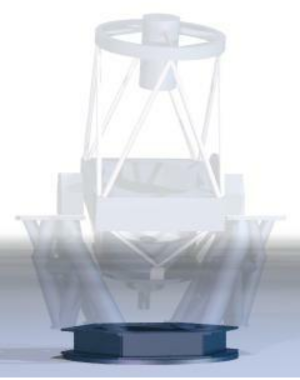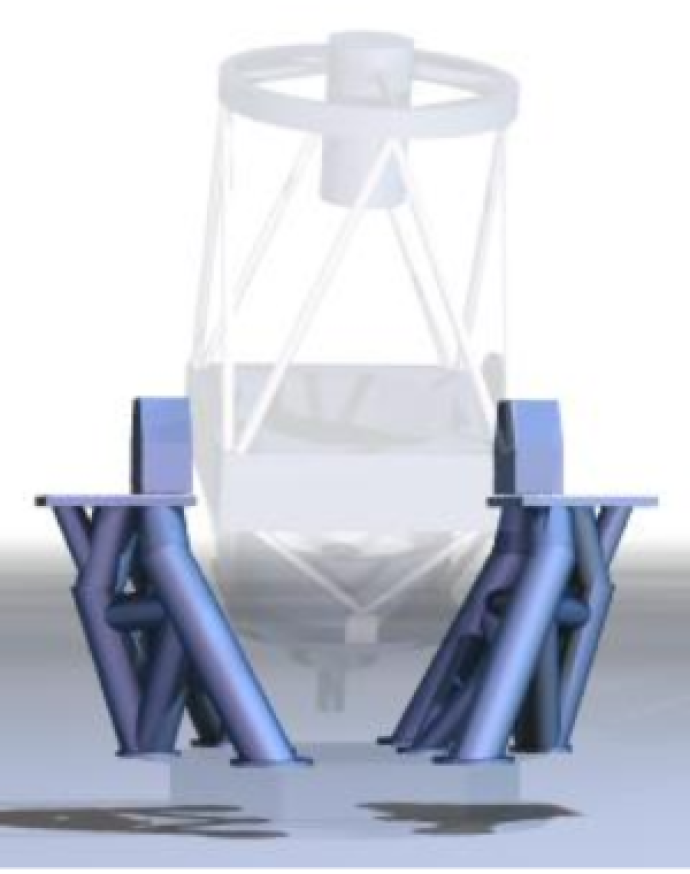The Liverpool Telescope (LT) is a robotic telescope with a 2-metre-diameter mirror. Astronomers and young people all over the world use it to study the Universe. Schools can use the telescope through The Schools' Observatory.
Because it is fully robotic and does not need people on site, it can be used by anyone using the internet.
After sunset, the LT's computer systems check the weather conditions. If the weather is good, the roof opens up like a clamshell.
The telescope works all night through a list of observation requests sent during the daytime. Once the data has been collected, the LT sends it back to whoever asked for it.

Liverpool John Moores University owns and looks after the telescope. Scientists and engineers in and around Liverpool, UK, designed and built it. But despite its name, the Liverpool Telescope is not in Liverpool. It is on the Spanish island of La Palma, off the coast of northwest Africa. This is because the weather and conditions on La Palma are much better for astronomy than in Liverpool!
The telescope is 8.5 metres tall and 6.5 metres wide. It weighs around 24 metric tonnes, the same as 4 African elephants! Despite its huge size, the LT can move quickly to look at different parts of the sky. Engineers designed the telescope to respond to new events far away in space. It can receive a request and start observing a different part of the sky within minutes.
The telescope has a huge mirror, which means the LT can collect lots of light from objects far away in space. Mirrors also direct the light towards a set of scientific instruments. As well as collecting visible light that our eyes can see, the LT can see in infrared light. It also has spectrometers that let astronomers study the chemistry of stars in space.
A special enclosure protects the mirror and instruments from rain or bad weather. The shape of the enclosure keeps air flowing over the telescope. This prevents turbulence in the air close to the telescope. Any turbulence would make the images look blurry.

Telescope Design:
- The Base
The base of the telescope supports the whole structure.
Image CreditThis work by The Schools' Observatory is licensed under All rights reserved
CreditThis work by The Schools' Observatory is licensed under All rights reservedIt is home to (azimuth) bearings, which let the telescope move from side to side (horizontally). These bearings have two flat metal surfaces that glide smoothly across each other on a thin layer of oil, which lets the telescope to follow the stars accurately.
The telescope must be level when it is working; if not, it won't be able to track stars moving across the sky at night and take photographs. The telescope base is level to within 20 microns, the thickness of a human hair!
It is also important that the telescope is placed on concrete. We call the concrete base a pier. The pier stops vibrations from around the site disturbing the instrument's sensitive measurements.
- The Instruments
The LT can have up to 6 different instruments for science.
Image CreditThis work by The Schools' Observatory is licensed under All rights reserved
CreditThis work by The Schools' Observatory is licensed under All rights reservedThe LT has a professional digital camera to capture images (data) of objects in the night sky. As well as the optical camera, there is also an infrared one.
There are other instruments, too, such as a polarimeter and spectrographs. These let astronomers measure distances in the Universe and the elements making up stars and other objects.
- The Mirrors
The LT uses two main mirrors.
Image CreditThis work by The Schools' Observatory is licensed under All rights reserved
CreditThis work by The Schools' Observatory is licensed under All rights reservedThe first is the primary mirror at the bottom of the telescope. It is 2 metres in diameter and weighs over a tonne. Its purpose is to get as much light as possible from the stars. The surface is curved so that light is brought to a point or focus, which is where we would use a digital camera is placed to take an image of a small part of the night. The primary mirror has to be made to high standards and is the most expensive part of the telescope.
The other mirror is called the secondary mirror. It is found at the top of the telescope. Its purpose is to bounce the light back towards a hole in the middle of the primary mirror. This lets the light focus on the instruments, making the images clear. This mirror is also made very precisely, which takes a lot of time.
- The Mirror Cell
The mirror cell holds the large primary mirror in place as the telescope moves to view different parts of the night sky. This is not an easy task, as the mirror is made from glass and weighs about 1.1 tonnes.
Image CreditThis work by The Schools' Observatory is licensed under All rights reserved
CreditThis work by The Schools' Observatory is licensed under All rights reservedWith such a heavy weight, the telescope flexes slightly, especially when it moves from a position looking at the horizon to one pointing straight up (zenith).
The mirror cell compensates for these slight movements in the telescope's structure and keep the optics aligned.
- The Yokes
The yokes let the telescope move up and down. They also support the mirrors and instruments.
Image CreditThis work by The Schools' Observatory is licensed under All rights reserved
CreditThis work by The Schools' Observatory is licensed under All rights reservedThe telescope moves vertically (up and down) on its altitude axis. The bearings for this movement are at the top of the yoke. These are the same type as those used to move the telescope side to side.
The yoke is specially designed to be as rigid as possible. This is important for when the telescope moves or when it's windy. Vibrations caused by these movements blur the images taken by the telescope.
The LT has been designed to operate at up to 80 km/hour wind speeds.
- The Centre Section
Weighing about 3 tonnes, this part of the telescope is at the top of the yokes.
Image CreditThis work by The Schools' Observatory is licensed under All rights reserved
CreditThis work by The Schools' Observatory is licensed under All rights reservedThe centre section spins on the altitude bearings to move the telescope up and down.
It is also the main structure that attaches the mirror cell and telescope top through trusses.
- The Trusses
The mirrors are located at the top and bottom of the telescope. They are secured to the centre section using steel trusses.
Image CreditThis work by The Schools' Observatory is licensed under All rights reserved
CreditThis work by The Schools' Observatory is licensed under All rights reservedThese trusses give rigidity and support to the heavy primary mirror at the base and the secondary mirror at the top.
The two mirrors must be kept in line with each other. Imagine the telescope in a horizontal position. The weight of the mirrors, especially the primary mirror, will stress the trusses. This can cause a bending effect.
To stop this, the trusses form triangles along which the stress can travel. A triangle is a very sturdy shape. Bridges and other large structures use triangles to create stability.
You can try this out using straws; make a number of structures, and then add more straws to make triangles in your structure. You will notice that it becomes stronger and more stable.
- The Top Cell
This curved structure forms the top of the telescope.
Image CreditThis work by The Schools' Observatory is licensed under All rights reserved
CreditThis work by The Schools' Observatory is licensed under All rights reservedThe top trusses hold it to the main body of the telescope. The secondary mirror is then secured to this.
It has a motor to let the telescope focus. The focus is found by carefully moving the secondary mirror nearer or further away from the primary mirror below. These movements are controlled to within less than the thickness of a human hair while the range of movement can be as much as 5 cm.
